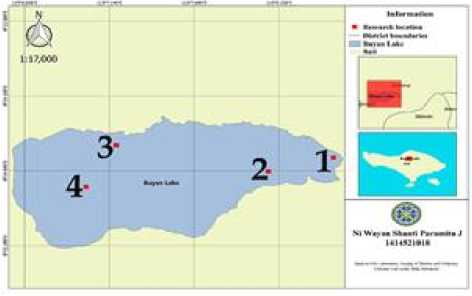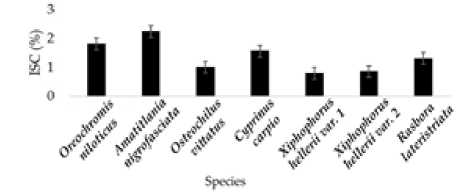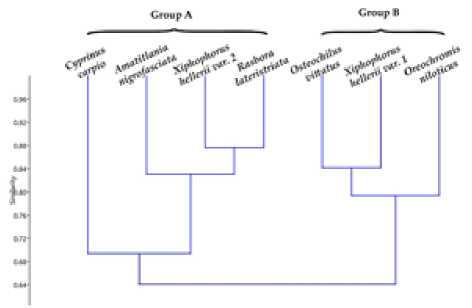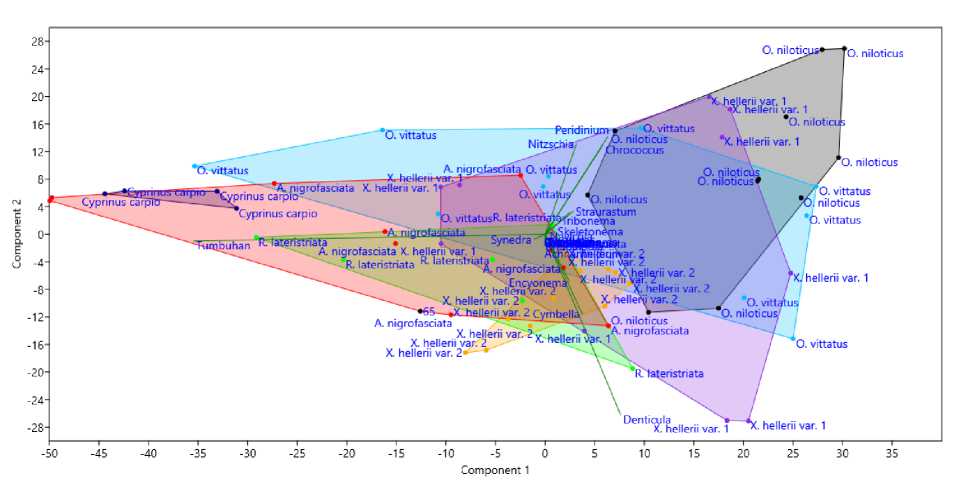The Competition among Fish Species Based on Types of Food in Buyan Lake, Bali, Indonesia
on
Journal of Marine and Aquatic Sciences 6(1), 118-124 (2020)
The Competition among Fish Species Based on Types of Food in Buyan Lake, Bali, Indonesia
Ni Wayan Shanti Paramita Jayanti a*, Pande Gde Sasmita Julyantoro a, Gde Raka Angga Kartika a
a Program Studi Manajemen Sumberdaya Perairan, Fakultas Kelautan dan Perikanan, Universitas Udayana, Jimbaran, Badung, Bali-Indonesia
* Penulis koresponden. Tel.: +62-8585-7622-167
Alamat e-mail: shantiparamita1996@gmail.com
Diterima (received) 11 Mei 2018; disetujui (accepted) 21 September 2020; tersedia secara online (available online) 22 September 2020
Abstract
Buyan Lake is located in Bali Province, this lake has a variety of fish species which several of those species are introduced species that called as alien fish. The relationship interaction between native fish and introduced fish can be described based on the study of food habit and competition of food types. The study was conducted from January to March 2018. Types of fish caught in Buyan Lake during the study were 7 species of fish namely Oreochromis niloticus, Amatitlania nigrofasciata, Osteochilus vittatus, Cyprinus carpio, Xiphophorus hellerii var. 1, Xiphophorus hellerii var. 2, and Rasbora lateristriata. The results showed that the fish with the highest ISC value was Amatitlania nigrofasciata, while the fish with the lowest ISC (Index of Stomach Content) value was Xiphophorus hellerii var. 1. The standard deviation range of almost all fish species is close to zero, so it is suspected that the contents of the stomach are nearly similiar. Amatitlania nigrofasciata with the highest standard deviation values are thought to have a variety of gastric contents. Based on the analysis of the contents of the stomach content, Oreochromis niloticus, Osteochilus vittatus, and Xiphophorus hellerii var. 2 are belonging to herbivorous fish. While Amatitlania nigrofasciata, Cyprinus carpio, Xiphophorus hellerii var. 1, and Rasbora lateristriata are belonging to omnivorous fish, which are tending to herbivores. The competition of food type is quite strict, there is similarity of food among species of fish in Buyan Lake, which is mean that they are fighting over the same food resources.
Keywords: Buyan Lake; fish; food habit
Abstrak
Danau Buyan terletak di Provinsi Bali, danau ini memiliki jenis spesies ikan yang beranekaragam dengan beberapa spesies ikan merupakan ikan asing. Hubungan interaksi antara ikan asli dengan ikan introduksi dapat dideskripsikan berdasarkan kajian kebiasaan makannya dan bagaimana persaingan jenis makanannya. Penelitian dilakukan dari bulan Januari-Maret 2018. Pengamatan dilakukan pada lambung ikan. Jenis ikan yang tertangkap di Danau Buyan selama penelitian adalah 7 jenis ikan yaitu Ikan Nila (Oreochromis niloticus), Ikan Zebra Cichlid (Amatitlania nigrofasciata), Ikan Nilem (Osteochilus vittatus), Ikan Mas (Cyprinus carpio), Ikan Platy Pedang varian 1/ Nyalian Srembeng (Xiphophorus hellerii var. 1), Ikan Platy Pedang varian 2/ Nyalian Mas (Xiphophorus hellerii var. 2), dan Ikan Wader/ Nyalian Buluh (Rasbora lateristriata). Hasil penelitian menunjukkan bahwa Ikan dengan nilai ISC tertinggi adalah Ikan Zebra Cichlid, sedangkan ikan dengan nilai ISC terendah adalah Ikan Platy Pedang varian 1. Kisaran standar deviasi hampir seluruh jenis ikan mendekati nol atau kecil, sehingga diduga isi lambungnya seragam. Ikan Zebra Cichlid dengan nilai standar deviasi tertinggi diduga memiliki isi lambung yang beragam. Berdasarkan analisis isi lambung, Ikan Nila, Ikan Nilem, dan Ikan Platy Pedang varian 2 termasuk ikan herbivora, sedangkan Ikan Zebra Cichlid, Ikan Mas, Ikan Platy Pedang varian 1, dan Ikan Wader termasuk ikan omnivora cenderung herbivora. Persaingan jenis makanan cukup ketat, terdapat kemiripan jenis makanan antar spesies ikan di Danau Buyan atau dengan kata lain saling memperebutkan sumber daya makanan yang sama.
Kata Kunci: Danau Buyan; ikan; kebiasaan makan
One of the lakes in Bali is Buyan Lake located in Pancasari Village, Buleleng Regency of Bali Province. Buyan Lake has a diverse variety of fish such as Osteochilus vittatus, Amatitlania nigrofasciata, Oreochromis niloticus, Oreochromis mossambicus, Cyprinus carpio, and Shrimp. Amatitlania nigrofasciata has the highest catching amount (Restu et al., 2016). Meanwhile, Sravishta et al. (2018), reported that the composition of fish catching in Buyan Lake can be found 9 species such as Oreochromienis niloticus, Osteochilus sp., Xiphophorus helleri, Rasbora lateristriata, Cyprinus carpio L, Amatitlania nigrofasciata, Puntius sp., Clarias gariepinus and Macrobrachium sp. Some of these fish species are introduced species or commonly called as alien fish. Introduction of alien fish species for the purpose of increasing fish production economically possible in the short term, but if this is done irresponsibly, it would be negative effect for native fish to the detriment of long-term basis (Muchlisin, 2011). Negative impacts of alien fish are predation of native species by alien species that can cause disturbances to the environment and biodiversity (Billman et al., 2011), pressing recruitment and suppress the growth of native species (Kostecki et al., 2011), and carry parasites or transmit disease (Nico et al., 2011).
The existence of alien species is suspected as one of the cause and threats of loss of biodiversity in fresh water related to predation and competition (Uzunova and Zlatanova, 2007). The decreasing in native fish populations is a preliminary process towards the extinction of certain species that can lead to biodiversity decline and ends with dominance by alien fish and the formation of a homogeneous fish community as one of the impacts of fish introduction (Sentosa and Satria, 2015). The relationship interaction between native fish and introduced fish can be described based on the study of food habit. The mechanism of food selection in fish may depend on the type of natural food present in their environment as well as on the agro climatic conditions (Offem, 2009). Growth and development in aquatic biota is determined by the availability of natural feed and fish species that use it (Umar and Kartamihardja, 2017). Although the information about the food competition between species are very important, the study of food competition, between fish species in Buyan Lake has not been done, so it is necessary to do research to analyze it.
-
2.1 Time and Location
The study was conducted at Buyan Lake stations (Figure 1) from January to March 2018, while analysis on fish organs was done at Fisheries Laboratory, Faculty of Marine and Fisheries, Udayana University.

Figure 1. Research Location
-
2.2 Tools and Materials
The tools used in this research include gill net, fish trap, GPS, plastic bag, microtube, digital scales, microscope, optic lab, laptop, dissecting set, glove, micropipette, measuring cylinder, tissue, sedgewick rafter, and dropper drops. While the materials needed in this study include fish samples, 70% alcohol, and aquadest.
-
2.3 Research Method
This research used quantitative descriptive method. Quantitative descriptive research method is a method used for examining on a particular sample, collecting data using research instruments, analyzing statistical data, testing the hypothesis (Sugiyono, 2012).
-
2.3.1. Sampling
Fish sampling was done by catching fish using gill net and fish trap. The size of the gill net used were 1 cm, 5 cm, and 6.5 cm. Gill net and fish trap were set, then soaked for about 24 hours operated permanently in the waters by using anchors of wood and establish perpendicularly. Before fish trap was setting and soaking, fish feed and stone as ballast were added to fish trap. After gill net and fish trap were lifted, the captured fish were released.
The captured fish was preserved in 70% alcohol solution and put in a cool box containing ice.
-
2.3.2. Observation and Measurement of Fish Organ
Observation and measurement of fish organ were done by taken 5 fishes each type at each station. The fish body was weighed and then dissected to remove the stomach. The contents of the stomach were diluted with distilled water. The stomach content such as type and amount of food, were observed by taking 1 ml of diluted stomach contents. Furthermore, the diluted stomach contents were placed on the segdewick rafter, to calculated the number of types of food organisms.
-
2.4 Data Analysis
-
2.4.1. Index of Stomach Content (ISC)
-
The Index of Stomach Content (ISC) was calculated to determine the relative consumption level of fish samples. ISC was determined using calculations according to Sphatura dan Gophen (1982) in Sulistiono et al. (2007):
SCW
ISC = x 100%
BW (1)
Which ISC means index of stomach content (%); SCW is weight of gastric contents (gr); and BW is individual fish weight (gr).
-
2.4.2. Similarity of Food Type
The similarity of food type was analyzed by using the similarity percentage method. Groupings are structured on the basis of similarity of food resources utilization by each fish species, Dendogram similarity of food type and principal component analysis type of fish food were processed by using PAleontological STatistics (PAST) version 3.1 software.
The fish caught in Buyan Lake during the study period were 7 species including 55 individu of Oreochromis niloticus, 55 individu of Amatitlania nigrofasciata, 50 individu of Osteochilus vittatus, 20 individu of Cyprinus carpio, 50 individu of Xiphophorus hellerii var. 1, 55 individu of Xiphophorus hellerii var.2, and 30 individu of Rasbora lateristriata.
-
3.1 Index of Stomach Content (ISC)
Index of Stomach Content or index of stomach fullness is used to determine the level of consumption of fish food. The average ISC value of each Oreochromis niloticus, Amatitlania nigrofasciata, Osteochilus vittatus, Cyprinus carpio, Xiphophorus hellerii var. 1, Xiphophorus hellerii var. 2, Rasbora lateristriata were 1,80% ± 0,59; 2,23% ± 1,02; 1,00% ± 0,30; 1,55% ± 0,25; 0,79% ± 0,19; 0,85 ± 0,21; and 1,31% ± 0,35, respectively (Figure 2).
The fish with the highest ISC value was Amatitlania nigrofasciata, while the lowest ISC value was Xiphophorus hellerii var. 1. Allegedly Amatitlania nigrofasciata are more active in foraging the food and can adapt to food that available in nature when compared with other types of fish such as Oreochromis niloticus, Osteochilus vittatus, Cyprinus carpio, Xiphophorus hellerii var. 1, Xiphophorus hellerii var. 2, and Rasbora lateristriata. According to Sulistiono et al. (2011), high gastric index values indicate active fish foraging. Moreover, Amatitlania nigrofasciata have been reported to adaptive ability in the fluctuations of food availability it can utilize the existing food resources in the waters more optimally (Sentosa and Wijaya, 2013).
The largest standard deviation value was found in Amatitlania nigrofasciata, while the lowest standard deviation value was Xiphophorus hellerii var. 1. The standard deviation value shows the amount of stomach that have substance and does not have substance (Sulistiono et al., 2011). The standard deviation range of almost all fish species is close to zero or small, so it is indicated that the contents of the stomach were similiar. Amatitlania nigrofasciata with the highest standard deviation values are thought to have a variety of gastric contents. According to Safitri (2012), the different standard deviation values indicate the range of gastric weight, the greater the standard deviation, the more diverse the weight of the fish's hull.

Figure 2. Average ISC Comparison
-
3.2 Similarity of Food Type
Based on gastric analysis, Oreochromis niloticus, Osteochilus vittatus, and Xiphophorus hellerii var. 2 are part of herbivorous fish. While Amatitlania nigrofasciata, Cyprinus carpio, Xiphophorus hellerii var. 1, and Rasbora lateristriata are part of omnivorous fish which are tending to herbivores. Omnivorous fish have ecological advantages. These fish have more food choices and are more able to survive when they have a decrease in the amount of food that is commonly consumed in the water (Offem et al., 2010, Alaş et al., 2010). The types of foods identified from the observations of gastric contents consist of plants, phytoplankton, and zooplankton. Percentage of food types in each type of fish has different values (Figure 3).
Fish with the highest percentage of plant consumption is Cyprinus carpio, while the lowest is Oreochromis niloticus. Fish that has the highest percentage of phytoplankton consumption is Oreochromis niloticus, while the lowest is Cyprinus carpio. The highest percentage of zooplankton consumption is Amatitlania nigrofasciata, Group of fish that do not eat zooplankton are Oreochromis niloticus, Osteochilus vittatus, and Xiphophorus hellerii var. 2. Differences in food between fish can be seen on the graph of percentage in the following fish food types (Figure 3).

Figure 3. Comparison of Fish Foods
Equal utilization of food resources between fishes can be described by using dendogram based on similarity percentage (Figure 4). Based on the similarity of fish food types, it is divided into two groups: group A and B. In group A, Xiphophorus hellerii var. 2 and Rasbora lateristriata has 87% similarity value; Amatitlania nigrofasciata and Xiphophorus hellerii var. 2, Rasbora lateristriata of 83%; Cyprinus carpio and Amatitlania nigrofasciata, Xiphophorus hellerii var. 2, Rasbora lateristriata 69%. While in group B, Osteochilus vittatus and
Xiphophorus hellerii var. 1 have a similarity value of 84%; Oreochromis niloticus and Osteochilus vittatus, Xiphophorus hellerii var. 1 of 79%. The similarity value between group A and group B of 64%. Fish that has the highest similarity value is Xiphophorus hellerii var. 2 and Rasbora lateristriata. While the lowest similarity value is group A and group B.

Figure 4. Dendogram Similarity of Food Type
The PCA (Principal Components) analysis illustrate the food competition between fish species in Buyan Lake (Figure 5). The competition seems quite tight, all types of fish have the type of food that related each other. This proves that there are similarities between types of food foe each fish species in Buyan Lake means the fish are fighting with each other over the same food resources. Amatitlania nigrofasciata tangles with 5 types of fish (Cyprinus carpio, Osteochilus vittatus, Xiphophorus hellerii var. 1, Xiphophorus hellerii var. 2, and Rasbora lateristriata) so it has a high competition. Xiphophorus hellerii var. 1 tangent to 5 types of fish (Osteochilus vittatus, Oreochromis niloticus, Amatitlania nigrofasciata, Rasbora lateristriata, and Xiphophorus hellerii var. 2). Osteochilus vittatus tangles with 5 types of fish (Xiphophorus hellerii var. 1, Xiphophorus hellerii var. 2, Rasbora lateristriata, Amatitlania nigrofasciata, and Oreochromis niloticus). Cyprinus carpio is tangent to 5 types of fish (Amatitlania nigrofasciata, Osteochilus vittatus, Oreochromis niloticus, Xiphophorus hellerii var. 1, and Rasbora lateristriata). Oreochromis niloticus tangles with 3 types of fish (Osteochilus vittatus, Xiphophorus hellerii var. 1, and Xiphophorus hellerii var. 2). Rasbora lateristriata tangent to 4 types of fish (Amatitlania nigrofasciata, Osteochilus vittatus, Xiphophorus hellerii var. 1, and Xiphophorus hellerii var. 2). While the Cyprinus carpio only tangles with Amatitlania nigrofasciata, so it has the lowest competition.

Figure 5. Principal Component Analysis Type of Fish Food in Buyan Lake
Based on the similarity of food type, the native fish to alien fish with the highest resemblance are Rasbora lateristriata and Xiphophorus hellerii var. 2, Osteochilus vittatus and Xiphophorus hellerii var. 1, Amatitlania nigrofasciata and Rasbora lateristriata. This can lead to food competition. If the population of Amatitlania nigrofasciata, Xiphophorus hellerii var. 2, and Xiphophorus hellerii var. 1 are increasing, the competition will be higher and might depress the population of Osteochilus vittatus and Rasbora lateristriata as the native species. Depressed Rasbora lateristriata population is caused by the famine of food. This is supported by Tampubolon (2013), which was said that there will be famine on fish which then decrease the rate of growth or population if the contested food resources are not available in sufficient quantities. Changed component on food chain will give effect to disrupt the growth and welfare of fish who has a fondness for certain types of food (Rennie et al., 2009). It is not impossible that Osteochilus vittatus and Rasbora lateristriata will be eliminated because Amatitlania nigrofasciata is the highest fish catching in Buyan Lake (Restu et al., 2016).
Although equally be a competitor and invasive fish for native fish, Amatitlania nigrofasciata do not have economic value when compared to other alien fish that can be sold and have a higher economic value. Targeted alien fish (hunted by fishermen) such as Oreochromis niloticus, Cyprinus carpio, Xiphophorus hellerii var. 1, and Xiphophorus hellerii var. 2 populations can be controlled by being captured and utilized by fishermen. Another case with
Amatitlania nigrofasciata whose population can not be suppressed by simply relying on the catch of fishermen because as a non-target fish (bycatch). Therefore, Amatitlania nigrofasciata population needs to be controlled by other actions. Amatitlania nigrofasciata have no economic value because they can not be consumed. In addition, Amatitlania nigrofasciata has been detrimental to fishermen for destroying the nets of fishermen. According to Sravishta et al. (2018), Amatitlania nigrofasciata was caught dominant in the nets when the arrest took place and has no economic value, Amatitlania nigrofasciata was the dominant fish found in the waters of Lake Buyan because it is not utilized. The presence of Amatitlania nigrofasciata which tends to be invasive has also been detrimental to fishing activities in Lake Beratan (Rahman et al., 2012)
Amatitlania nigrofasciata is generalist in choosing food and are able to adjust the food fluctuations (Sentosa and Wijaya, 2013). In addition, reinforced by the high competition from the Amatitlania nigrofasciata, Xiphophorus hellerii var. 1, and Xiphophorus hellerii var. 2 which are intersect with 5 types of fish. This proves that the competition of food type is quite strict, there is similarity of food among species of fish in Buyan Lake, which is mean that they are fighting over the same food resources.
The fish with the highest ISC value was Amatitlania nigrofasciata, and the fish with the lowest ISC value was the Xiphophorus hellerii var. 1. The standard
deviation range of almost all fish species is close to zero or small, so it is indicated that the contents of the stomach are uniform. Amatitlania nigrofasciata with the highest standard deviation values are thought to have a variety of gastric contents.
Fish that has the highest similarity value is Xiphophorus hellerii var. 2 with Rasbora lateristriata. While the lowest similarity values are group A fish (Cyprinus carpio, Amatitlania nigrofasciata,
Xiphophorus hellerii var. 2, and Rasbora lateristriata) with group B (Osteochilus vittatus, Xiphophorus hellerii var. 1, and Oreochromis niloticus). The competition of food type is quite strict, there is similarity of food among species of fish in Buyan Lake, which is mean that they are fighting over the same food resources.
Acknowledgements
The authors wish to acknowledge to Faculty of Marine and Fisheries Udayana University, Fisheries Laboratory Faculty of Marine and Fisheries Udayana Univesity, I Gusti Agung Dwikhy Oka Taradhipa, Ni Kadek Suardiani, Ilham Muttaqin, Bachori Dhian Pratama, Dimas Hafidh Nugroho, Pande Komang Ngurah Sanjaya, I Bagus Andreana Surya Nugraha, Gagah Gumelar Wicaksono, Ira Maresa, Ni Putu Suci Mardani, Ni Putu Bella Yuliana Dewi, Pande Adhitya Prabhuwinata Putra for helping fluency in the research process.
References
Alaş, A., Altındağ, A., Yılmaz, M., Kırpık, M. A., & Ak, A.
-
(2010) . Feeding Habits of Tench (Tinca tinca L., 1758) in Beyşehir Lake (Turkey). Turkish Journal of Fisheries and Aquatic Sciences, 10(2), 187–194.
Billman, E. J., Tjarks, B. J., & Belk, M. C. (2011). Effect of predation and habitat quality on growth and reproduction of a stream fish. Ecology of freshwater fish, 20(1), 102-113.
Kostecki, C., Rochette, S., Girardin, R., Blanchard, M., Desroy, N., & Le Pape, O. (2011). Reduction of flatfish habitat as a consequence of the proliferation of an invasive mollusc. Estuarine, Coastal and Shelf Science, 92(1), 154-160.
Muchlisin, Z. A. (2011). Analisis kebijakan introduksi spesies ikan asing di perairan umum daratan Provinsi Aceh. Journal Kebijakan Sosial Ekonomi Kelautan dan Perikanan, 1(1), 79-89.
Nico, L. G., Sharp, P., & Collins, T. M. (2011). Imported Asian swamp eels (Synbranchidae: Monopterus) in North American live food markets: Potential vectors of nonnative parasites. Aquatic Invasions, 6(1), 69–76.
Offem, B. O., Akegbejo-Samsons, Y., & Omoniyi, I. T. (2010). Aspects of Ecology of Clarias anguillaris (Teleostei: Clariidae) in the Cross River, Nigeria. Turkish Journal of Fisheries and Aquatic Sciences, 10(1), 101-110.
Offem, B. O., Samsons, Y. A., & Omoniyi, I. T. (2009). Trophic ecology of commercially important fishes in the Cross River, Nigeria. The Journal of Animal & Plant Sciences, 19(1), 37-44.
Rahman, A., Sentosa, A. A., & Wijaya, D. (2012). Sebaran ukuran dan kondisi ikan zebra Amatitlania nigrofasciata (Günther, 1867) di Danau Beratan, Bali. Jurnal Iktiologi Indonesia, 12(2), 135-145.
Rennie, M. D., Sprules, W. G., & Johnson, T. B. (2009). Factors affecting the growth and condition of lake whitefish (Coregonus clupeaformis). Canadian Journal of Fisheries and Aquatic Sciences, 66(12), 2096-2108.
Restu, I. W., Kartika, G. R. A., & Pratiwi, M. A. (2016). Potential identification of flora and fauna lake Buyan as basis for tourism development strategy based on aquatic ecosystems. In Proceedings of the 16th World Lake Conference. Bali, Indonesia, 7-11 November 2016 (pp. 160-166).
Safitri, H. (2012). Kebiasaan makan ikan kuniran Upeneus moluccensis (Bleeker, 1855) hasil tangkapan di perairan Selat Sunda. Skripsi. Bogor, Indonesia: Departemen Manajemen Sumberdaya Perairan, Fakultas Perikanan dan Ilmu Kelautan, Institut Pertanian Bogor.
Sentosa, A. A., & Satria, H. (2015). Kebiasaan makan beberapa jenis ikan yang tertangkap di rawa kaiza Sungai Kumbe Kabupaten Merauke, Papua. LIMNOTEK-Perairan Darat Tropis di Indonesia, 22(1), 32-41.
Sentosa, A. A., & Wijaya, D. (2013). Potensi invasif ikan zebra cichlid (Amatitlania nigrofasciata Günther, 1867) di Danau Beratan, Bali ditinjau dari aspek biologinya. BAWAL Widya Riset Perikanan Tangkap, 5(2), 113-121.
Sravishta, I. M. S. K., Arthana, I. W., & Pratiwi, M. A. (2018). Pola dan Parameter Pertumbuhan Ikan Tangkapan Dominan (Oreochromis niloticus, Osteochilus sp. dan Xiphophorus helleri) di Danau Buyan Bali. Journal of Marine and Aquatic Sciences, 4(2), 204-212.
Sugiyono. (2012). Metode penelitian kuantitatif kualitatif dan r&d. (17th ed.). Bandung, Indonesia: Alfabeta.
Sulistiono, S., Firmansyah, A., Sofiah, S., Brojo, M., Affandi, R., & Mamangke, J. (2007). Aspek biologi ikan butini (Glossogobius matanensis) di Danau Towuti, Sulawesi Selatan. Jurnal Ilmu-ilmu Perairan dan Perikanan Indonesia, 14(1), 13-22.
Sulistiono., Sari, C., & Brodjo, M. (2011). Kebiasaaan makanan ikan lidah (Cynoglossus lingua) di perairan Ujung Pangkah, Gresik, Jawa Timur. Jurnal Ilmu-ilmu Perairan dan Perikanan Indonesia, 17(1), 205-214.
Tampubolon, P. A. R. P. (2013). Karakter ekobiologi ikan oskar (Amphilophus citrinellus günther, 1864) sebagai
dasar pengendalian ikan asing di waduk IR. H. Djuanda, Jawa Barat. Tesis. Bogor, Indonesia: Program Studi Pengelolaan Sumber Daya Perairan, Sekolah Pascasarjana, Institut Pertanian Bogor.
Umar, C., & Kartamihardja, E. S. (2017). Hubungan panjang-berat, kebiasaan makan dan kematangan
gonad ikan bilih (Mystaecoleucus padangensis) di Danau Toba, Sumatera Utara. BAWAL Widya Riset Perikanan Tangkap, 3(6), 351-356.
Uzunova, E & Zlatanova, S. (2007). A review of the fish introductions in Bulgarian freshwater. Acta Ichthyologica et Piscatoria, 37(1), 55-61.
© 2020 by the authors; licensee Udayana University, Indonesia. This article is an open access article distributed under the terms and conditions of the Creative Commons Attribution license (http://creativecommons.org/licenses/by/3.0/).
J. Mar. Aquat. Sci. 6: 118-124 (2020)
Discussion and feedback